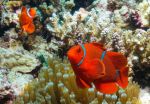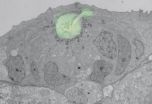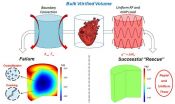Arrested development -- Sediment wreaks havoc with fish larvae
2014-10-23
(Press-News.org) Sediments associated with dredging and flood plumes could have a significant impact on fish populations by extending the time required for the development of their larvae, according to Australian researchers.
"Sediment concentrations at levels found in plumes from dredging or in floods cause a significant delay in the development of clownfish larvae," says study lead author, Dr Amelia Wenger, from the ARC Centre of Excellence for Coral Reef Studies (Coral CoE) at James Cook University.
"This in turn could significantly reduce the numbers of larvae competent to settle on reefs and could have a major effect on adult populations," Dr Wenger says.
As part of the study examining the impact of sediment on young fish, researchers took five-day-old clownfish larvae and raised them under four different sediment levels.
Larvae raised in even slightly elevated sediment took much longer to develop than those raised in the absence of sediment.
In many cases larval development time doubled from the normal 11 days to 22 days.
Dr Wenger explains that this delay is a significant problem for fish because they are at their most vulnerable during this stage of development.
"The pelagic larval stage is when you get the highest level of mortality, so the longer fish spend as larvae the less likely they are to survive," she says.
"During this time they can be in open water away from the protection of the reef so if a fish is spending twice as long in this stage it means their risk from predators is greatly increased," Dr Wenger says.
Researchers say this will have a big impact on population dynamics for fish exposed to sediment levels associated with dredging and flood plumes.
Study co-author, Professor Geoff Jones from Coral CoE, says that with the exception of a few species, almost all fish have a pelagic larval stage, so this is something that they could all experience.
"We don't know if all fish are going to be as sensitive to sediment as clownfish, but if you don't get new recruits into a population then you won't have any new ones to replace the adults when they die off," Professor Jones says.
"This early development is a crucial stage for fish recruitment and population viability."
INFORMATION:
Paper
Suspended sediment prolongs larval development in coral reef fish by Amelia S. Wenger, Mark I McCormick, Geoff K.Endo, Ian M. McLeod, Frederieke J. Kroon and Geoffrey P. Jones is published in The Journal of Experimental Biology http://jeb.biologists.org/content/217/7/1122.short
Image
Clownfish. Image credit – Erika Woolsey
Contact
Dr Amelia Wenger, Coral CoE - +61 7 4781 4804
amelia.wenger@my.jcu.edu.au
Professor Geoff Jones, Coral CoE
geoffrey.jones@jcu.edu.au
Eleanor Gregory, Communications Manager Coral CoE, 0428 785 895, eleanor.gregory@jcu.edu.au
[Attachments] See images for this press release:

ELSE PRESS RELEASES FROM THIS DATE:
2014-10-23
Loggerhead turtles (Caretta caretta) from Cape Verde start their life with a swimming sprint and a ride on favourable ocean currents. In this way, they escape quickly from predator-rich coastal areas and make their way to the safer open ocean where they spend several years feeding and growing. In this study, tiny acoustic transmitters provided direct insight into these pathways for the first time. "Thanks to the new technology we can start to fill in key information gaps about the so-called 'lost years' Dr. Rebecca Scott states. Funded by the Kiel Cluster of Excellence ...
2014-10-23
From basketball to handball, rugby to American football, teams in a variety of sports huddle together to agree tactics in secret. Cells, too, can huddle to communicate within a restricted group, scientists at the European Molecular Biology Laboratory (EMBL) in Heidelberg, Germany, have found. The study, published today in Nature, is the first demonstration that the way cells organise themselves influences their ability to communicate. The researchers propose that this strategy, which they discovered in developing zebrafish, could be much more widespread, influencing processes ...
2014-10-23
Successful techniques for cryopreserving bulk biomaterials and organ systems would transform current approaches to transplantation and regenerative medicine. However, while vitrified cryopreservation holds great promise, practical application has been limited to smaller systems (cells and thin tissues) due to diffusive heat and mass transfer limitations, which are typically manifested as devitrification and cracking failures during thaw. Here we leverage a clinically proven technology platform, in magnetically heated nanoparticles, to overcome this major hurdle limiting ...
2014-10-23
Narrowband or hyperspectral imaging is a valuable technique used in planetary science for characterizing surfaces and surrounding environments. For example, it can be used to spatially map molecular species of interest on the surface of a solid or icy body, or to sound to different depths in a giant planet atmosphere. However, conducting narrowband or hyperspectral imaging of solar system targets from a balloon-borne platform presents several technical challenges, including mechanical failures and power requirements. These risks can be mitigated with the use of an electronically ...
2014-10-23
Amsterdam, October 23, 2014 - Herbal medicines such as licorice, Indian rennet and opium poppy, are at risk of contamination with toxic mould, according to a new study published in Fungal Biology. The authors of the study, from the University of Peshawar, Pakistan say it's time for regulators to control mould contamination.
An estimated 64% of people use medicinal plants to treat illnesses and relieve pain. The herbal medicine market is worth $60 billion globally, and growing fast. Despite the increasing popularity of herbal medicine, the sale of medicinal plants is mostly ...
2014-10-23
Needham, MA.–JBJS Case Connector, an online case journal published by the Journal of Bone and Joint Surgery, has issued a "Watch" regarding concerns over flexible reamer breakage during anatomic single-bundle ACL reconstruction. Flexible reamers help surgeons achieve optimal femoral-tunnel parameters, but they are prone to breakage in certain situations, as the "Watch" article explains.
This "Watch" is based largely on a report published in the October 22, 2014 issue of JBJS Case Connector by Lee, et al., examining two cases of single-bundle anatomic ACL reconstruction ...
2014-10-23
PROVIDENCE, R.I. [Brown University] — Pay attention to the implication of these new research results: People who pay more attention to their feelings and experiences tend to have better cardiovascular health.
As noted more precisely in a new study in the International Journal of Behavioral Medicine, researchers at Brown University found a significant association between self-reported "dispositional mindfulness" and better scores on four of seven cardiovascular health indicators, as well as a composite overall health score. Dispositional mindfulness is defined as ...
2014-10-23
A study led by the researcher at the Institute of Biomedical Research (IDIBELL), Isabel Fabregat, could serve to select patients with hepatocellular carcinoma unresponsive to most frequently used drug in liver cancer: sorafenib. The study, published in the International Journal of Cancer describes how tumor cells that have a less differentiated phenotype (mesenchymal) and expresses CD44, do not respond to Sorafenib action.
Difficult treatment
Hepatocellular carcinoma is one of the cancers with the worst prognosis and more difficult treatment. Surgery is only possible ...
2014-10-23
This news release is available in German. Bio-engineers are working on the development of biological computers with the aim of designing small circuits made from biological material that can be integrated into cells to change their functions. In the future, such developments could enable cancer cells to be reprogrammed, thereby preventing them from dividing at an uncontrollable rate. Stem cells could likewise be reprogrammed into differentiated organ cells.
The researchers have not progressed that far yet. Although they have spent the past 20 years developing individual ...
2014-10-23
Scientists at the University of Manchester, King's College London and the University of Liverpool have found that an infant's preference for a person's face, rather than an object, is associated with lower levels of callous and unemotional behaviors in toddlerhood.
The study, which was published in Biological Psychiatry, assessed if 213 five-week-old infants spent longer tracking a person's face compared to an inanimate object – in this case a red ball.
The researchers showed that greater tracking of the face relative to the ball was linked to lower callous unemotional ...
LAST 30 PRESS RELEASES:
[Press-News.org] Arrested development -- Sediment wreaks havoc with fish larvae





